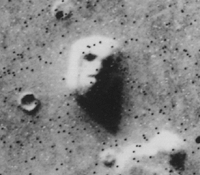Pareidolia (nonfiction)
Jump to navigation
Jump to search
Pareidolia (/pærɪˈdoʊliə/ parr-i-DOH-lee-ə) is a psychological phenomenon in which the mind responds to a stimulus, usually an image or a sound, by perceiving a familiar pattern where none exists (e.g., in random data).
Common examples are perceived images of animals, faces, or objects in cloud formations, the Man in the Moon, the Moon rabbit, hidden messages within recorded music played in reverse or at higher- or lower-than-normal speeds, and hearing indistinct voices in random noise such as that produced by air conditioners or fans.
In the News
Fiction cross-reference
Nonfiction cross-reference
- Calendrical pareidolia (nonfiction) - the phenomenon of responding to a calendar-based stimulus (such as births and deaths, occurring on the same day in the calendar but otherwise evidencing no causal relationship) by perceiving a familiar pattern where none exists.
- Mars (nonfiction)
External links:
- Pareidoila @ Wikipedia
- Artist Kyle Kesterson draws the faces he sees in things @ Boing Boing
- Accidental Maps - specializing in a pareidolia of places.
